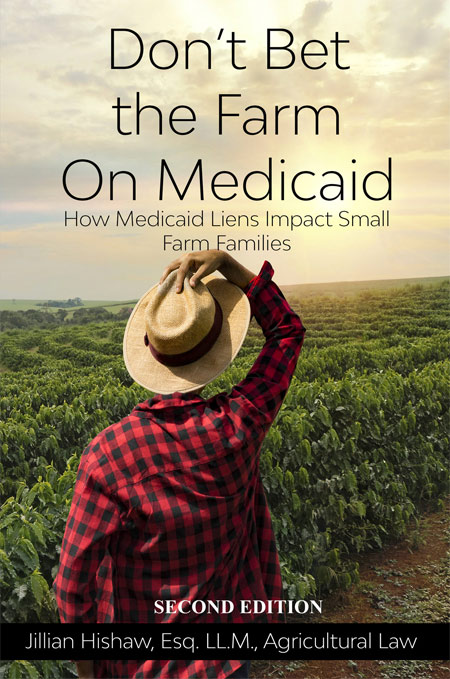About the Implications of Medicaid Liens
While the fact that the American farming population is an aging one1 may seem like old news, in terms of arable land loss, this
A former USDA Adjudicator, Agricultural Attorney, and Founding Director of Family Agriculture Resource Management Services (F.A.R.M.S.), a national nonprofit that provides technical and legal services to aging small farmers, Hishaw maintains that we need to understand the implications of Medicaid liens in relation to eldercare and the asset protection of seniors — before it's too late.

With the average age of U.S. farmers projected to continue increasing based on anticipated USDA Census data, the call for aging services for farmers is escalating and neglected. While most individuals over 65 seek health care coverage through Medicaid, the need to protect one's property to qualify is often overlooked until the need for long-term care is imminent. For farmers who are often "land rich and cash poor," the need to protect generational owned land and qualify for Medicaid should not be a choice. Farmers should never be forced to sell their land to cover nursing care costs. This book was written to provide general information about Medicaid and its impact on small farmers, specifically regarding Medicaid lien enforcement.
An issue to which Hishaw has recently brought our attention is how many of her farm clients suffer from the challenge of losing land ownership to a Medicaid lien. These challenges inspired her to write Don't Bet the Farm on Medicaid, now in its third edition. The book defines what a Medicaid lien is, ways to prevent it, and through examination of nearly 20 state laws determines whether any state-specific lien exemptions exist.
Johnny's asked Hishaw to provide our readers with insight into elder care basics and the technicalities of Medicaid liens.
- Medicaid is a dual federal and state public assistance program for low-income elderly and disabled individuals. As many farmers prepare to enter long-term care facilities, one must complete proper estate planning prior to applying for Medicaid to ensure the land is protected from a Medicaid lien.
- If a Medicaid recipient owes an outstanding debt to their nursing facility, the facility has the federal authority to place a Medicaid lien on the recipient's home or land. As more farmers transition off the land and into the nursing home, land loss may also result from Medicaid liens.
- Most farm families cannot afford the average $7700 monthly nursing home costs.2
- According to a 2017 USDA Economic Research Service Report, 48% of U.S. farms generated less than $10,000 in annual revenue.3
- If you are 55 years and older and receive Medicaid, your assets are subject to a Medicaid lien.
- Prior to qualifying for Medicaid as a landowner, you should consider transferring ownership over to a loved one, to avoid the being penalized by Medicaid.
- If you transfer an asset less than 5 years prior to applying for Medicaid, you may have to wait to receive benefits.
- The 5-year look- back period covers an applicant's assets transferred or sold 5 years prior to qualifying for Medicaid. For example, if you transferred your 20-acre farm to your daughter in 2017 but applied for Medicaid in 2020, you will suffer a penalty and have to wait until 2022, a total of 5 years following the asset transfer, before qualifying for Medicaid. Remember, you can only qualify if you meet the low-income requirements outlined in your particular state.
- As a Medicaid recipient you do not have to live away from the farm. You can continue to live on the farm and receive in-home care.
- As a farmer you can still qualify for Medicaid if you transfer the land and were provided with a life estate deed.
- A life estate deed allows you to live in your home and land until death.
Through her work with disenfranchised landowners to retain land through various estate planning and land protection means, as well as engaging young people about the importance of small farms in our nation, Hishaw helps preserve the availability of farmland options to the next generation.
To learn more about her work, visit jillianhishaw.com. To learn about F.A.R.M.S., visit 30000acres.org. If it's within your power, please consider lending your support to their efforts!
Footnotes
1 USDA National Agricultural Statistics Service (NASS). 2017 Census of Agriculture. URL: https://www.nass.usda.gov/Publications/AgCensus/2017/index.php (accessed 09.14.2020).
2 Genworth 2016 Cost of Care Survey, conducted by CareScout®, April 2016. URL: https://www.genworth.com/about-us/industry-expertise/cost-of-care.html (accessed 09.14.2020).
3 2015 USDA Economic Research Services Report. URL: https://www.ers.usda.gov/data-products/ag-and-food-statistics-charting-the-essentials/farming-and-farm-income/ (accessed 09.14.2020).


